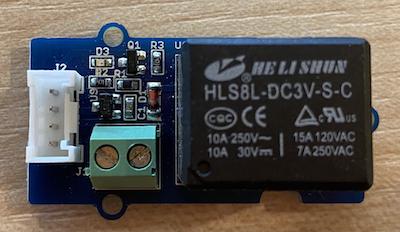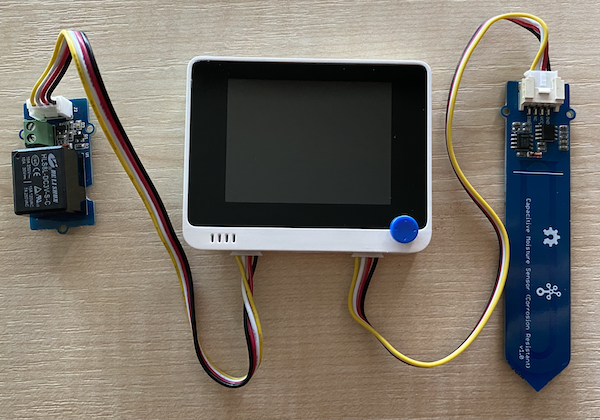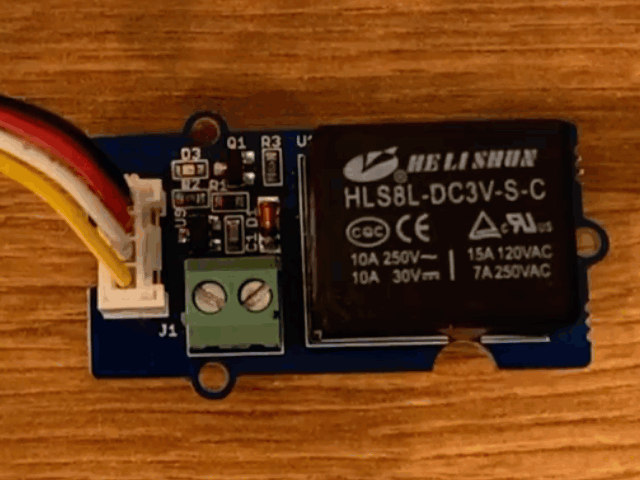4.6 KiB
Control a relay - Wio Terminal
In this part of the lesson, you will add a relay to your Wio Terminal in addition to the soil moisture sensor, and control it based off the soil moisture level.
Hardware
The Wio Terminal needs a relay.
The relay you'll use is a Grove relay, a normally-open relay (meaning the output circuit is open, or disconnected when there is no signal sent to the relay) that can handle output circuits up to 250V and 10A.
This is a digital actuator, so connects to digital pins on the Wio Terminal. The combined analog/digital port is already in use with the soil moisture sensor, so this plugs into the other port, which is a combined I2C and digital port.
Connect the relay
The Grove relay can be connected to the Wio Terminals digital port.
Task
Connect the relay.
-
Insert one end of a Grove cable into the socket on the relay. It will only go in one way round.
-
With the Wio Terminal disconnected from your computer or other power supply, connect the other end of the Grove cable to the left-hand side Grove socket on the Wio Terminal as you look at the screen. Leave the soil moisture sensor connected to the right-hand socket.
- Insert the soil moisture sensor into soil, if it isn't already from the previous lesson.
Program the relay
The Wio Terminal can now be programmed to use the attached relay.
Task
Program the device.
-
Open the
soil-moisture-sensorproject from the last lesson in VS Code if it's not already open. You will be adding to this project. -
There isn't a library for this actuator - it's a digital actuator controlled by a high or low signal. To turn it on, you send a high signal to the pin (3.3V), turn turn it off you send a low signal (0V). You can do this using the built-in Arduino
digitalWritefunction. Start by adding the following to the bottom of thesetupfunction to setup the combined I2C/digital port as an output pin to send a voltage to the relay:pinMode(PIN_WIRE_SCL, OUTPUT);PIN_WIRE_SCLis the port number for the combined I2C/digital port. -
To test the relay is working, add the following to the
loopfunction, below the finaldelay:digitalWrite(PIN_WIRE_SCL, HIGH); delay(500); digitalWrite(PIN_WIRE_SCL, LOW);The code writes a high signal to the pin that the relay is connected to to turn it on, waits 500ms (half a second), then writes a low signal to turn the relay off.
-
Build and upload the code to the Wio Terminal.
-
Once uploaded, the relay will turn on and off every 10 seconds, with a half second delay between turning on and off. You will hear the relay click on then click off. An LED on the Grove board will light when the relay is on, then go out when the relay is off.
Control the relay from soil moisture
Now that the relay is working, it can be controlled in response to soil moisture readings.
Task
Control the relay.
-
Delete the 3 lines of code that you added to test the relay. Replace them with the following code in its place:
if (soil_moisture > 450) { Serial.println("Soil Moisture is too low, turning relay on."); digitalWrite(PIN_WIRE_SCL, HIGH); } else { Serial.println("Soil Moisture is ok, turning relay off."); digitalWrite(PIN_WIRE_SCL, LOW); }This code checks the soil moisture level from the soil moisture sensor. if it is above 450, it turns on the relay, turning it off if it goes below 450.
💁 Remember the capacitive soil moisture sensor reads lower the more moisture there is in the soil.
-
Build and upload the code to the Wio Terminal.
-
Monitor the device via the serial monitor. You will see the relay turn on or off depending on the soil moisture levels. Try in dry soil, then add water.
Soil Moisture: 638 Soil Moisture is too low, turning relay on. Soil Moisture: 452 Soil Moisture is too low, turning relay on. Soil Moisture: 347 Soil Moisture is ok, turning relay off.
💁 You can find this code in the code-relay/wio-terminal folder.
😀 Your soil moisture sensor controlling a relay program was a success!


